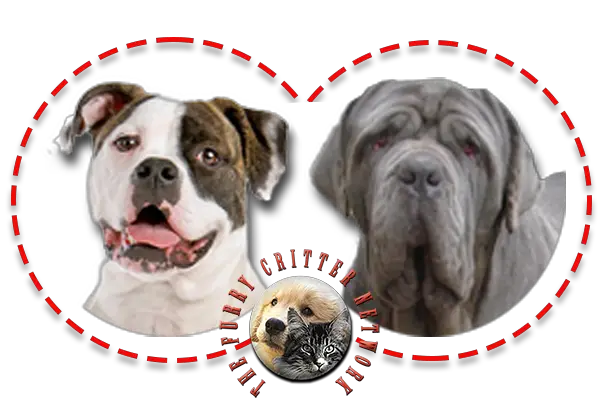Behavior
As a Neapolitan Mastiff owner, you have selected a guardian breed - one that is steady and loyal to his owner. He is not aggressive or apt to bite without reason. He is a true guardian of his property and to the family entrusted to him. His attitude is calm, yet cautious, and he is majestic and powerful. He is always watchful and does not take pleasure in strangers who intrude into his personal space.
Many times, dogs of any breed may develop behavioral problems which some may refer to as a bad temperment. If your dog barks menacingly or growls and snaps at anyone who comes near his food while eating or while he is resting, or if he is playful and happy one minute and growling and showing aggression or is agitated easily, then he is a candidate for professional behavioral training. Start by calling your breeder and see if he can offer you some training tips. Remember a dog is a pack animal, and you and family are part of the pack. Dogs know that there is always a leader in the pack, and you as the owner, must assume the role of LEADER of the pack. Your Neapolitan Mastiff must never be allowed to dominate you. Dog aggression, if left unchallenged, will get worse and may result in someone getting bitten. If your breeder is not responsive to your concerns, please do not despair. Contact your veterinarian and ask for a reliable reference of behavioral trainers that are familiar with the Neapolitan Mastiff breed.
One of the most important parts of training is constantly taking the time to reinforce that YOU are the pack leader. Training begins the moment you bring your Neapolitan Mastiff home. Do not give into your new friend. Remember that you love your Neapolitan Mastiff and want only what is best for him. You must socialize the Neapolitan Mastiff from an early age. Take your puppy to as many places as you can where there are people and other pets. This is referred to as 'socializing'. (Note: please remember that your puppy must have received the proper amount of vaccinations prior to socializing with other dogs). Also, placing your Neapolitan Mastiff puppy on a leash for the first time can be quite upsetting to him. This is due to the fact that the leash prevents the natural behavior of dogs, which is running. Dogs can demonstrate their lack of acceptance of humans by fighting the leash or running as far as the tether will allow in an attempt to escape human control. Waiting too long before starting socialization may prove to be harmful. Ideally, socialization should begin before 12 weeks of age.
How much socialization is necessary? During the socialization period, the puppy must experience different varieties of human beings and/or situations. Your puppy needs to experience sharing his space with children and adults of various ages. He must become acclimated to seeing people who wear hats, sunglasses, umbrellas, scarves, ties, individuals of different races or even people who wear perfume. Each of these experiences will provide a new socialization opportunity for your puppy. This can be time-consuming, but in the end it is time well-spent. Your Neapolitan Mastiff puppy should get as much socialization as possible through contact with people. Just be careful not to overwhelm the puppy with too many puppy play dates.
Obedience classes are always a must for any breed of canine. Keep in mind when a canine is removed from the regular presence of humans and other dogs during the juvenile period, they can lose their socialization; so again, enroll your Neapolitan Mastiff puppy into obedience class as soon as appropriate.
United States Neapolitan Mastiff Club
Health
Prone to cherry eye, hip dysplasia, bloat, pano-ostiosis (joint pain from growth can occur at 4-18 months and usually goes away on its own). Pups are usually born via caesarian section.






